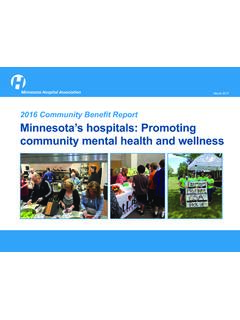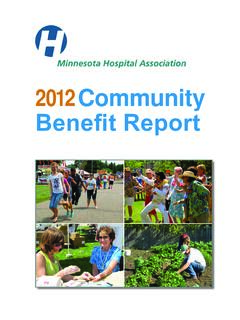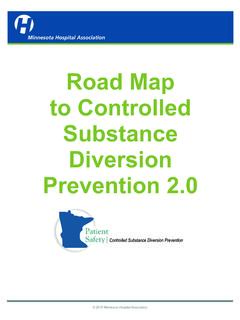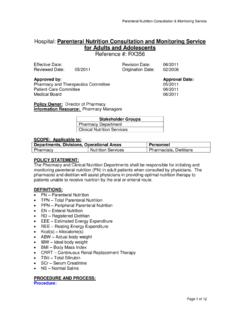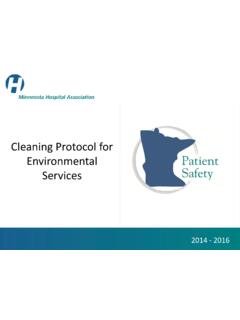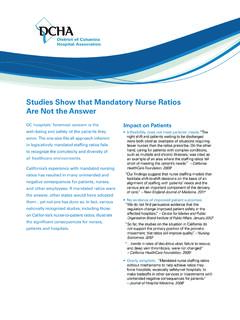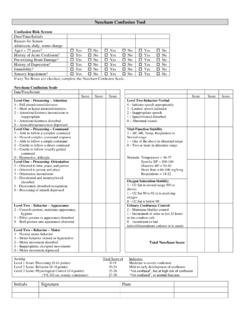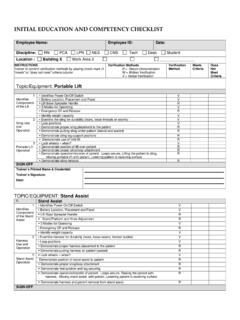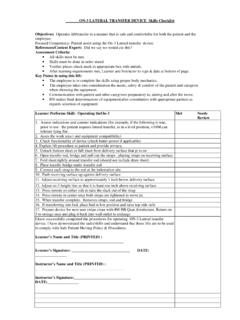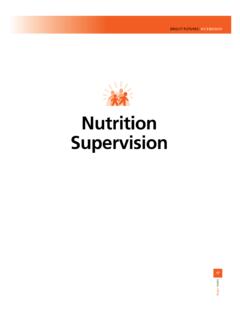Transcription of Hospital Guidelines: Inpatient Glycemic Management Guidelines
1 Inpatient Glycemic Management Guidelines Hospital Guidelines : Inpatient Glycemic Management Guidelines Reviewed Date: 01/2012 Revision Date: 01/2012. Origination Date: 09/2011. Approved by: Date of Approval: Inpatient Glycemic Control Team 01/2012. Guideline Owner: Inpatient Glycemic Control Team Information Resource: Diabetes Clinical Nurse Specialist Selected Content: Blood Glucose Monitoring Oral and Injectable Non-Insulin Anti-hyperglycemic Agents Insulin Therapy: Intravenous Insulin Protocols and Order Sets Scheduled Subcutaneous Insulin Subcutaneous Insulin Order Sets Glucocorticoid Therapy Insulin Pump Hypoglycemia Medical Nutrition Therapy Enteral Nutrition TPN.
2 Diabetes Self- Management Education (DSME). Discharge Planning Scope Target Population All adults within Hospital with hyperglycemia, the diagnosis of diabetes and pre-diabetes. Disease/Condition(s). Type 1 diabetes Type 2 diabetes Gestational diabetes Pre-diabetes Hyperglycemia Intended Users Physicians Physician Assistants Pharmacists Advanced Practice Nurses Nurses Dieticians Allied Health Personnel Methodology Method Used to Select the Evidence Revised 1/2012 Page 1 of 14. Inpatient Glycemic Management Guidelines Review of Diabetes Clinical Practice Guidelines from the American Diabetes Association, 1.
3 American Association of Clinical Endocrinologists, 2 and American College of Physicians. 3. Rating system for strength of the recommendations by these Guidelines from the American Diabetes Association and American Association of Clinical Endocrinologists. Level of Description Evidence*. A Clear or supportive evidence from adequately powered well-conducted, generalizable, Strong randomized controlled trials Compelling nonexperimental evidence B Supportive evidence from well-conducted cohort studies or case-control study Intermediate C Supportive evidence from poorly controlled or uncontrolled studies Weak Conflicting evidence with the weight of evidence supporting the recommendation E.
4 Not Evidence Expert consensus or clinical experience Based *Level of Evidence is indicated at the end of a sentence or paragraph with the applicable letter within parentheses. Method of Guideline Validation The Inpatient Glycemic Control Team reviewed recommendations and approved. Introduction In the Unites States, of the population has been diagnosed with diabetes. Of adults aged 20 years or older, 35% have prediabetes (2011).4 Patients with diabetes are more likely to be hospitalized and have longer length of stays by 1 to 3 days than those without A 2008. survey estimated that 22% of all Inpatient days were incurred by patients with In the last 6 months of 2010, 24% of inpatients were diagnosed with diabetes or hyperglycemia at _____ Hospital and had on average days longer length of stay than patients without diabetes or hyperglycemia.
5 Hyperglycemia in hospitalized patients has been associated with adverse outcomes in a wide range of conditions such as cardiac and non-cardiac surgery, acute MI, pneumonia, subarachnoid hemorrhage, blunt injury, and Mortality risk is actually greater in hyperglycemic patients without a history of In addition, hyperglycemia induces vasoconstriction, inflammation, thrombosis, dehydration, fluid and electrolyte imbalances, and impaired gastric In patients with well controlled diabetes prior to hospitalization, poor glucose Management undermines the patient's confidence in their Hospital caregivers. Initially, intensive treatment of hyperglycemia (80 to 110 mg/dL) was recommended for improved outcomes for hospitalized patients.
6 Multiple studies since have shown improved benefit with higher glucose targets (140-180 mg/dL) with less hypoglycemia and mortality among hospitalized ,2,3. Hospitalization is an opportunity to identify undiagnosed diabetes and intervene with patients who have poorly controlled diabetes. Hospital readmission within 30 days occurred with 31% of patients who had diabetes that was missed during hospitalization9 as well as for patients with Revised 1/2012 Page 2 of 14. Inpatient Glycemic Management Guidelines Patients in the Hospital should receive diabetes survival skill self- care Management education and new Glycemic control regimens if needed.
7 At discharge, optimal transition consists of communication and follow-up visits with appropriate professionals, including primary care provider, endocrinologist, and diabetes educator along with appropriate prescriptions for diabetes care supplies and medications. Recommendations All patients with diabetes admitted to the Hospital should have their diabetes identified in the medical record. (E). BLOOD GLUCOSE MONITORING. All patients with diabetes should have orders for blood glucose monitoring, with results available for all members of the health care team. (E) Point-of- care (POC) blood glucose monitoring performed at the bedside is used to guide therapy.
8 Any POC glucose result that does not correlate with the patient's status should be confirmed through conventional laboratory sampling of plasma Blood glucose monitoring should be ordered for any patient without the diagnosis of diabetes who receives therapy associated with high risk of hyperglycemia, including high-dose glucocorticoid therapy, enteral or parenteral nutrition, or other medications such as octreotide or immunosuppressive medications. (B) If hyperglycemia is documented and persistent, consider treating such patients to the same Glycemic goals as patients with known diabetes. (E). Glucose levels should be monitored minimally.
9 Before meals and bedtime for patients who are eating. The timing of glucose monitoring should be within 30 minutes before carbohydrate exposure. every 4 to 6 hours for patients who are NPO (4 hours if patient treated with rapid-acting insulin and 6 hours if patient treated with regular insulin). More frequent blood glucose monitoring ranging from every 30 minutes to every 2 hours is required for patients on intravenous insulin For pregnant patients who are eating, glucose levels should be monitored minimally as follows . for women with gestational diabetes mellitus (GDM): o before breakfast (fasting) and 1 hour postmeals (timing to start from the first bite of food).
10 For women with preexisting type 1 or type 2 diabetes : o before meals, 1 hour postmeals (timing to start from the first bite of food) and at Blood Glucose Level Goals For critically ill patients 140-180 mg/dL provided the target can be safely achieved. (A). Insulin therapy should be initiated starting at a threshold of no greater than 180 mg/dL. For non-critically ill patients <140 mg/dL if treated with insulin, with random blood glucose <180 mg/dL, provided these targets can be safely achieved. More stringent targets Revised 1/2012 Page 3 of 14. Inpatient Glycemic Management Guidelines may be appropriate in stable patients with previous tight Glycemic control.
